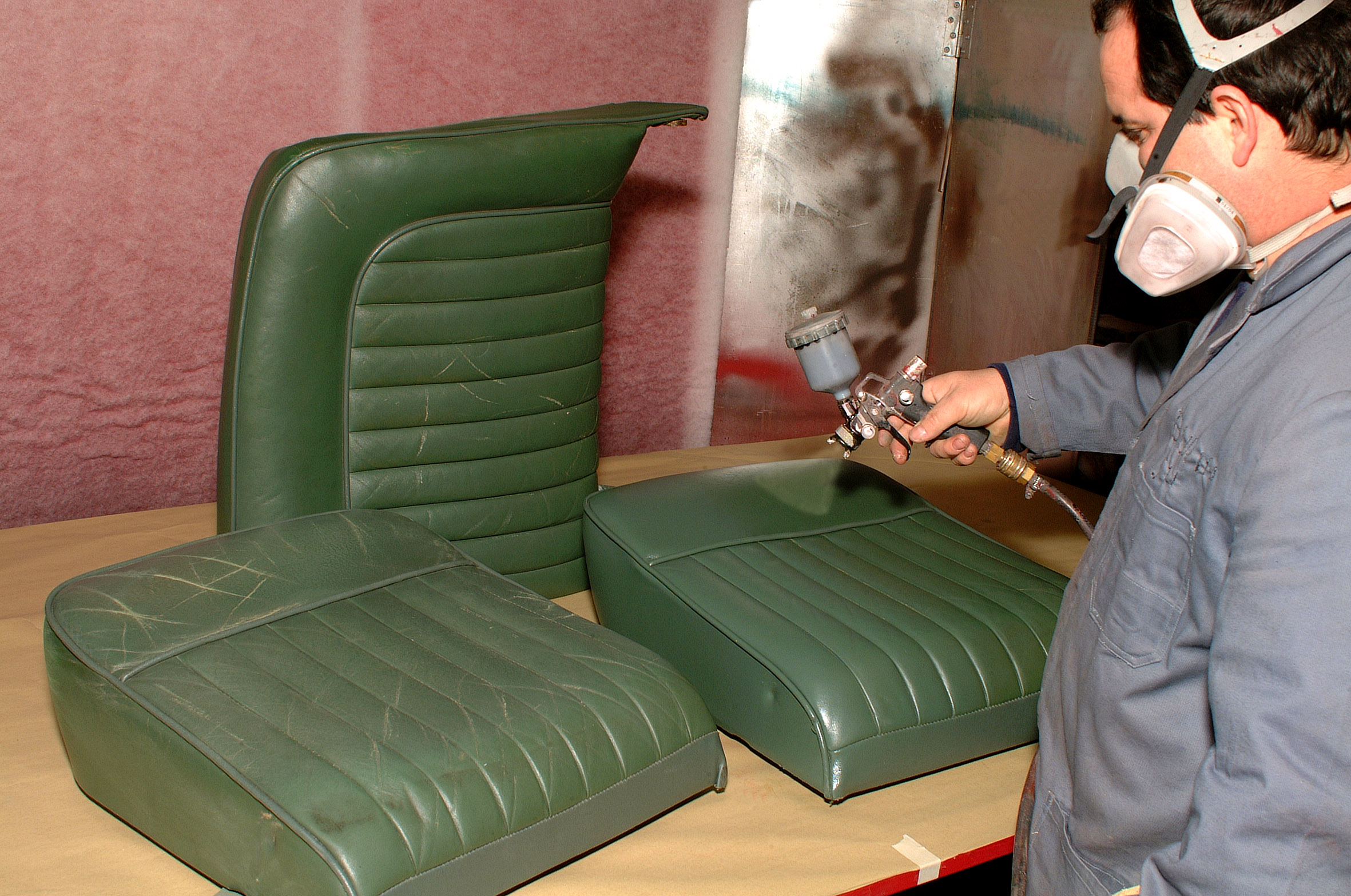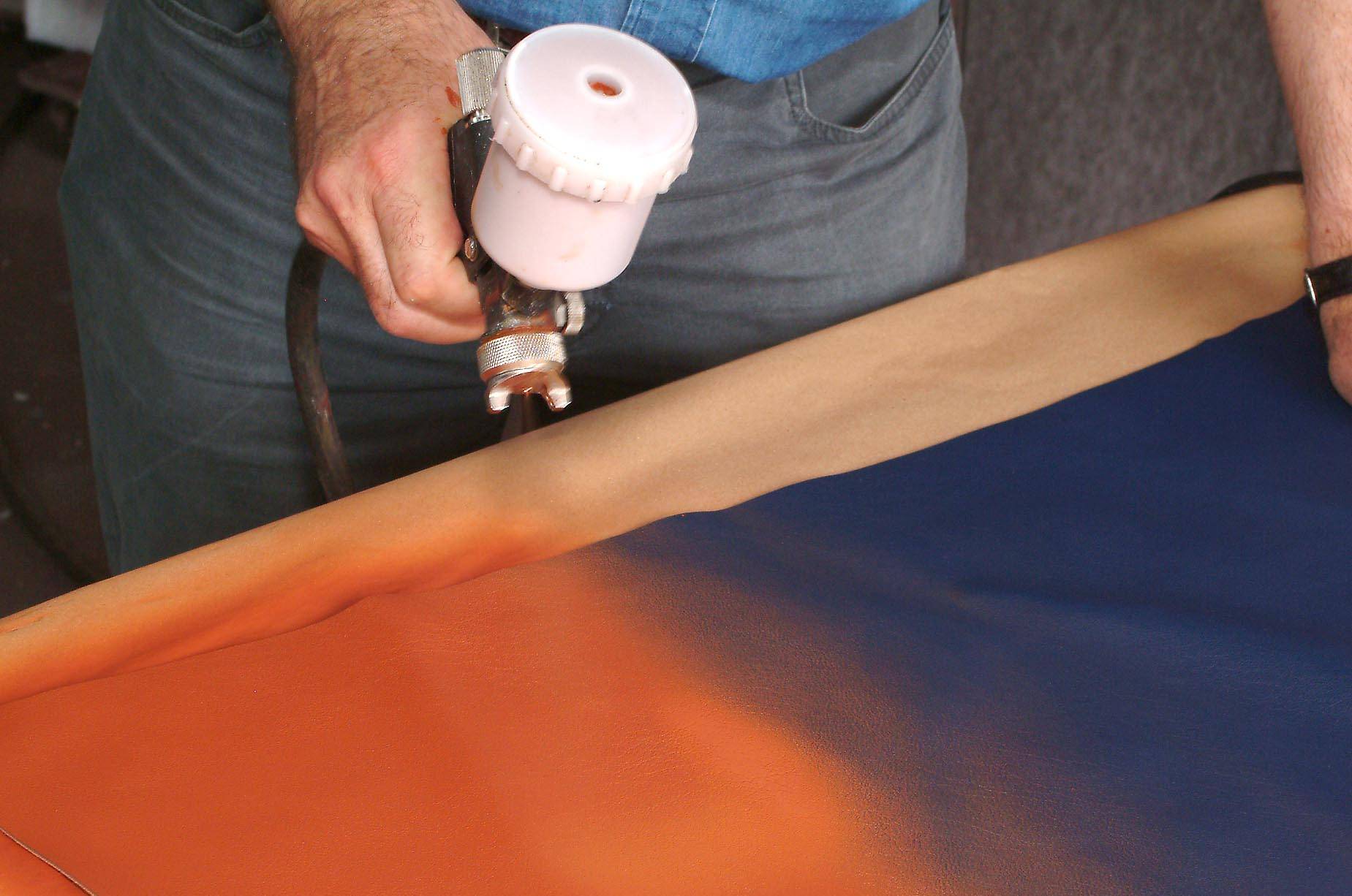How to colour pigmented leather - For Professionals
- The following instructions are for pigmented (top coated) Napa leather and not for Aniline, Nubuk or Suede leather (use special instructions for those leather types). Differentiation: Rub a drop of water on an undamaged area. If the water penetrates the surface and darkens the leather, its open pored Aniline. If water doesn't penetrate the leather, it's pigmented leather.
- Leather should only be coloured with experience in colouring with spray guns and the right equipment (airbrush, extraction system, breathing protection etc.).
- Changing colour of leather surfaces is more work than refreshing the original colour. You need far more paint and time and a helping hand to colour in all folds.
CLEANING
- De-assemble upholstery and covers as much as possible.
- Remove any dust from the leather with a vacuum cleaner or with compressed air. Compressed air is better for the cleaning of folds and piping edges. Remove any remaining dust with a soft brush.
- Clean visibly soiled leathers with COLOURLOCK Mild Leather Cleaner. Do not work too wet on damaged areas. Old leather shouldn't absorb water. Then treat older leathers (older than 15 years) with white vinegar (mixture 1:1 with water). Remove dirt in the grain with the COLOURLOCK Leather Cleaning Brush.
- Thoroughly clean and de-grease with COLOURLOCK Solvent Cleaner. Leather Colour should be seen on the cloth to make sure that any residues are removed and the surface is slightly dissolved. Carefully sand the surface with the COLOURLOCK Leather Sanding Pad and dedust without using cleaning liquids. The Solvent Cleaner and light sanding are important processes to ensure optimal colour adhesion!
REPAIRS
- Carefully smooth rough or cracking surfaces with the Leather Sanding Pad. Wipe off the dust using a moistened cloth.
- In case of cracks and rips, first smooth down sharp edges. Stick together the edges of rips with COLOURLOCK Leather Glue. Areas which have to be filled with COLOURLOCK Leather Filler must previously be treated with COLOURLOCK Primer. Using the filler, spread a light film about five millimetres left and right of the filled crack or rip. This strengthens the durability of the repair. Let the filler dry and repeat the procedure where necessary. Any unevenness can be removed with a Sanding Pad previously dipped in COLOURLOCK GLD. Important: Extremely old, brittle and weak leather should be replaced entirely. They can be repaired cosmetically, but colour and filler can never replace the leather’s strength.
COLOURING
- Spray the leather gently wet with COLOURLOCK Primerat low pressure (approx. 2 bar/15-32 psi) until the surface becomes slightly sticky after drying. Avoid thick coats of primer.
- Filter the COLOURLOCK Leather Colourbefore filling it into the spraying pistol! Apply the colour at low pressure (approx. 2 bar/15-32 psi) evenly and not too thickly. Always apply several layers and dry with a heat gun before applying the next layer until the surface is evenly coloured. Apply the colour only as thinly as necessary: Thick layers of colour affect stability and grip of the colouration. Pull apart folds and piping edges and treat those first. Always wear breathing protection during spraying. Work only in a well-ventilated space.
- Mix COLOURLOCK Top Coat with 1 % of COLOURLOCK Crosslinker IC2. Stir well and filter! Spray the mixture thinly over the dried colour and dry with a heat gun. Repeat if necessary. Mix only as much Top Coat with Crosslinker as you need in the following two hours. The Crosslinker is reactive and should not get in contact with water and humidity. Keep away from skin and eyes!
- Primer, Leather Colour and Top Coat can be dried with a heat gun and the steps should be performed successively to ensure that the fresh layers connect well.
- Smooth down rough areas with COLOURLOCK Polishing Pad 4000. Then, if necessary, again apply colour or only Top Coat.
- After 24 hours, rub a wet cloth on the colour to be sure that the surface has sufficiently been treated with Top Coat. In case of discolouration, the leather has to be treated with Top Coat again.
- Care the coloured leather with COLOURLOCK Leather Shieldin order to protect it against wear and scratches.
- One week after colouring, apply COLOURLOCK Leather Protector. Regularly repeat this care two to four times a year.
Required quantities for a complete furniture (incl. VAT, excl. shipping costs)
COLOURLOCK Mild Leather Cleaner - foam spender bottle
200 ml
$44.00
COLOURLOCK Leather Cleaning Brush
1 unit
$9.90
COLOURLOCK Solvent Cleaner
1 litre
$79.95
COLOURLOCK Leather Sanding Pad
1 unit
$8.90
COLOURLOCK Leather Glue
20 ml
$39.99
COLOURLOCK Leather Filler
7 ml tube
$46.00
COLOURLOCK GLD Solvent
225 ml
$34.95
COLOURLOCK Polishing Pad 4000
1 unit
$12.99
COLOURLOCK Primer
1 litre
$94.00
COLOURLOCK Leather Colour
2 litres (price / litre!)
$99.00
Extra charge for colour matching according to sample
$29.00
COLOURLOCK Colour Filter
3 pieces (price per filter!)
please ask for details
COLOURLOCK Top Coat Car & Furniture
1 litre
$94.00
COLOURLOCK Crosslinker IC2
50 ml
$69.95
COLOURLOCK Leather Shield
150 ml
$39.99
COLOURLOCK Leather Protector
150 ml
$39.99
The quantities above are sufficient for a complete set of equipment. Minimum quantity for matched colours is 1 litre. Most other products are also available in 250 ml bottles. We will be happy to adjust the quantities to suit your individual requirements.
 AUSTRALIA
AUSTRALIA


